The PreZero Arena hosted a tight contest in the Bundesliga between TSG Hoffenheim and Borussia Dortmund. This tactical analysis will break down the game that ended as a 1-0 victory to Dortmund.
Hoffenheim, led by Sebastian Hoeness, are having a very respectable start to the season under the new manager’s stewardship. Before this game, they had won their opening two games and only lost to the then top of the table Eintracht Frankfurt. In this analysis, we will discover how Hoeness’ tactics resulted in a narrow loss for die Kraichgauer.
Borussia Dortmund, managed by Lucien Favre, had the same record as Hoffenheim heading into this fixture, except they had a disappointing loss against Bundesliga minnows Augsburg. Favre has been experimenting with youth in his starting lineup so far this campaign, starting new signing Jude Bellingham in the first three league matches. This analysis will take a deeper dive into how they won this game, despite missing key men in defence.
Lineups
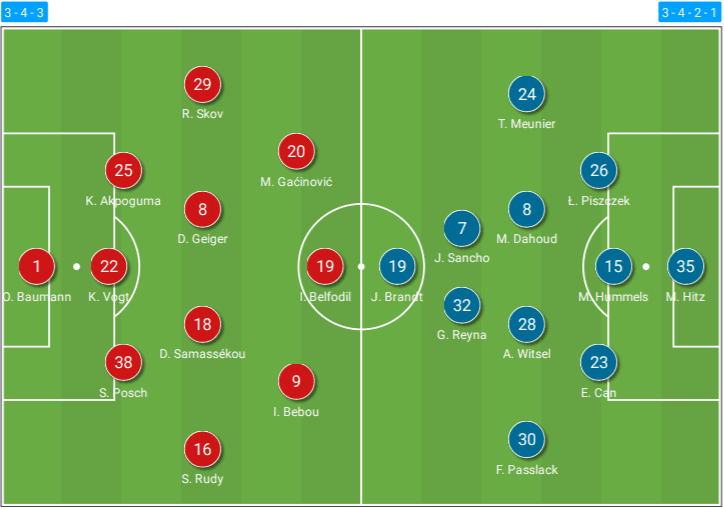
Hoffenheim (3-4-3): Oliver Baumann; Stefan Posch, Kevin Vogt, Kevin Akpoguma; Sebastian Rudy, Diadie Samassékou, Dennis Geiger, Robert Skov; Ihlas Bebou, Ishak Belfodil, Mijat Gaćinović.
Hoeness had plenty of injuries to contend with in the build-up to this fixture, including Benjamin Hübner, Ermin Bičakčić, Havard Nordtveit, Konstantinos Stafylidis and most importantly, Andrej Kramarić due to a positive coronavirus test. Belfodil returned to the lineup to make his first Bundesliga start in 391 days after requiring surgery in his knee which put him out of action for a prolonged period. Gaćinović also made his first league start for Hoffenheim in this game, fitting in as a left-winger against die Schwarzgelben. The rest of the side remained relatively unchanged, lining up in the same formation as the previous two fixtures.
Dortmund (3-4-2-1): Marwin Hitz; Łukasz Piszczek, Mats Hummels, Emre Can; Thomas Meunier, Mahmoud Dahoud, Axel Witsel, Felix Passlack; Jadon Sancho, Giovanni Reyna; Julian Brandt.
Dortmund have tried a few variations of a three-at-the-back this season already, but went with a 3-4-2-1 formation here, likely to compensate for the lack of a natural #9 in this game. Favre also had to deal with several first-team injuries, including Dan-Axel Zagadou, Manuel Akanji, Marcel Schmelzer, Nico Schulz and former Chelsea forward Thorgan Hazard. This forced the Swiss coach into playing Piszczek and Can as the wide centre-backs, with the latter covering that position all season long so far. Erling Braut Håland had started two matches within the last six days for Norway before this game, which led the ‘manchild’ to start this game on the bench. Dahoud and Passlack were also two surprise inclusions in this game, likely due to fatigue within Jude Bellingham and Raphaël Guerreiro from their international fixtures.
Hoffenheim’s build-up play in wide areas
As you would expect in a back three, the wing-backs play an important role in all phases of play. On paper, they have very offensive players in this area, such as Skov, Sessegnon, and Kadeřábek, but they all have to do their due diligence out of possession as well. In the defensive phase, the wing-backs turn into full-backs to tighten the spaces that rapid forwards can run into and to overload an area with players to win the ball back.
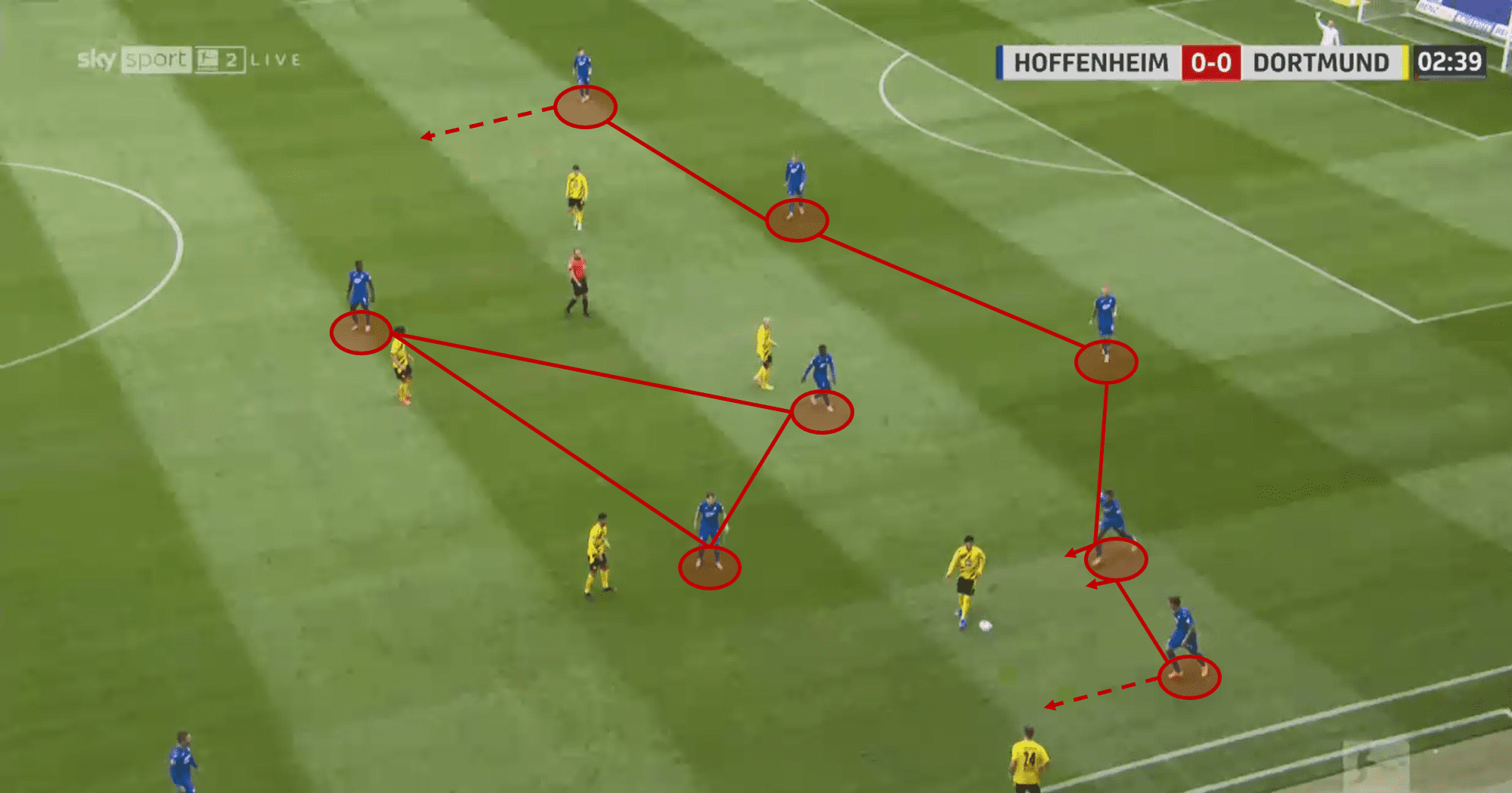
Out of possession, we can see Hoffenheim in a 5-3-2. Samassékou drops the deepest of the three midfielders, with Bebou dropping deeper to link the midfield into attack through a quick transition.
Simultaneously, when Baumann collects the ball, Hoeness looks for his wing-backs to push further up the field and position themselves in pockets of space to win the ball in an aerial duel. We saw this in their shock victory against Bayern Munich, where they exploited Alphonso Davies’ weakness in the air, with Kadeřábek constantly providing knock-downs to either Moanes Dabbur or Kramarić to run into the penalty area.
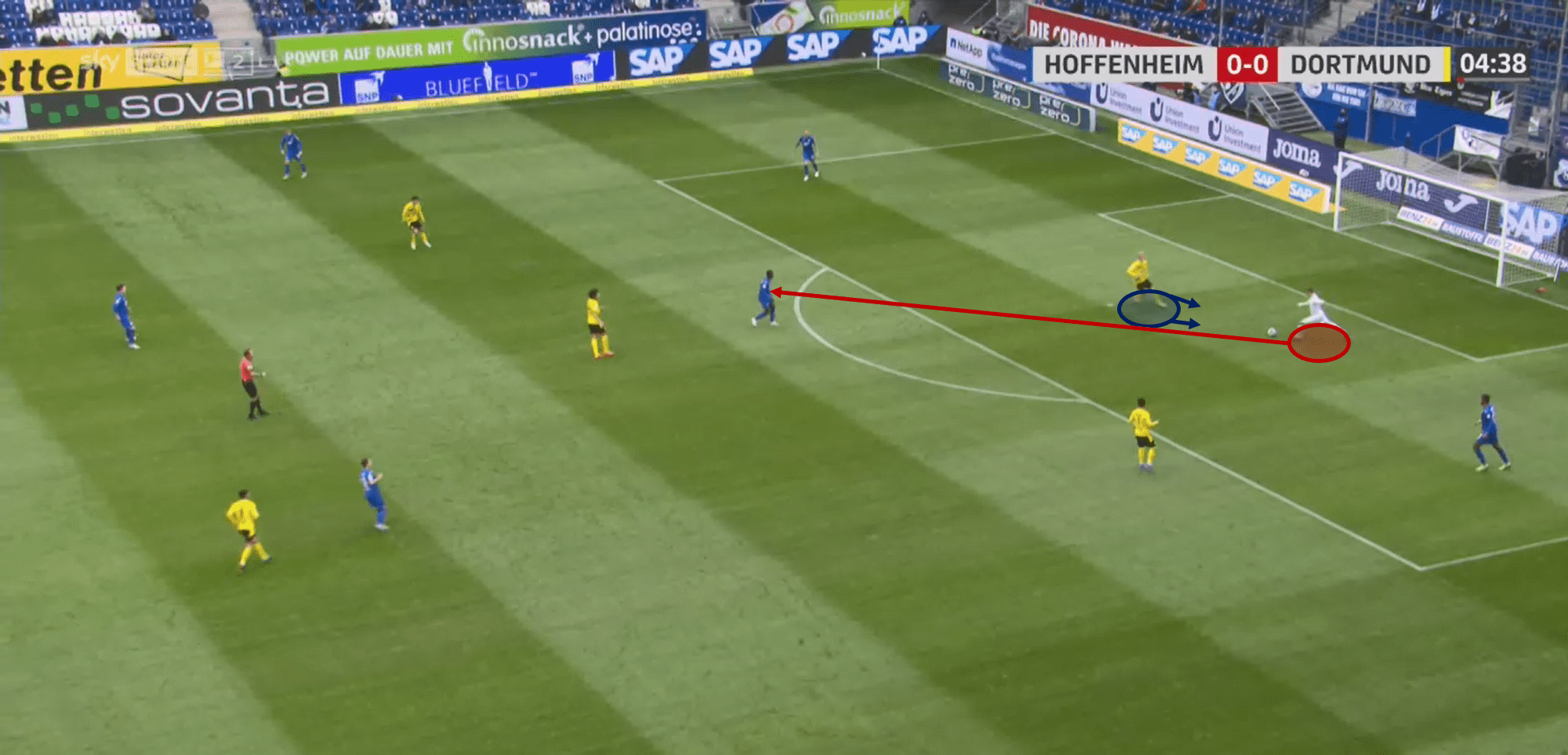
On the ball, Bauman waits for Brandt to engage the press before running up to kick the ball. Since Dortmund press as a unit, this brings the whole team a yard or so forward.
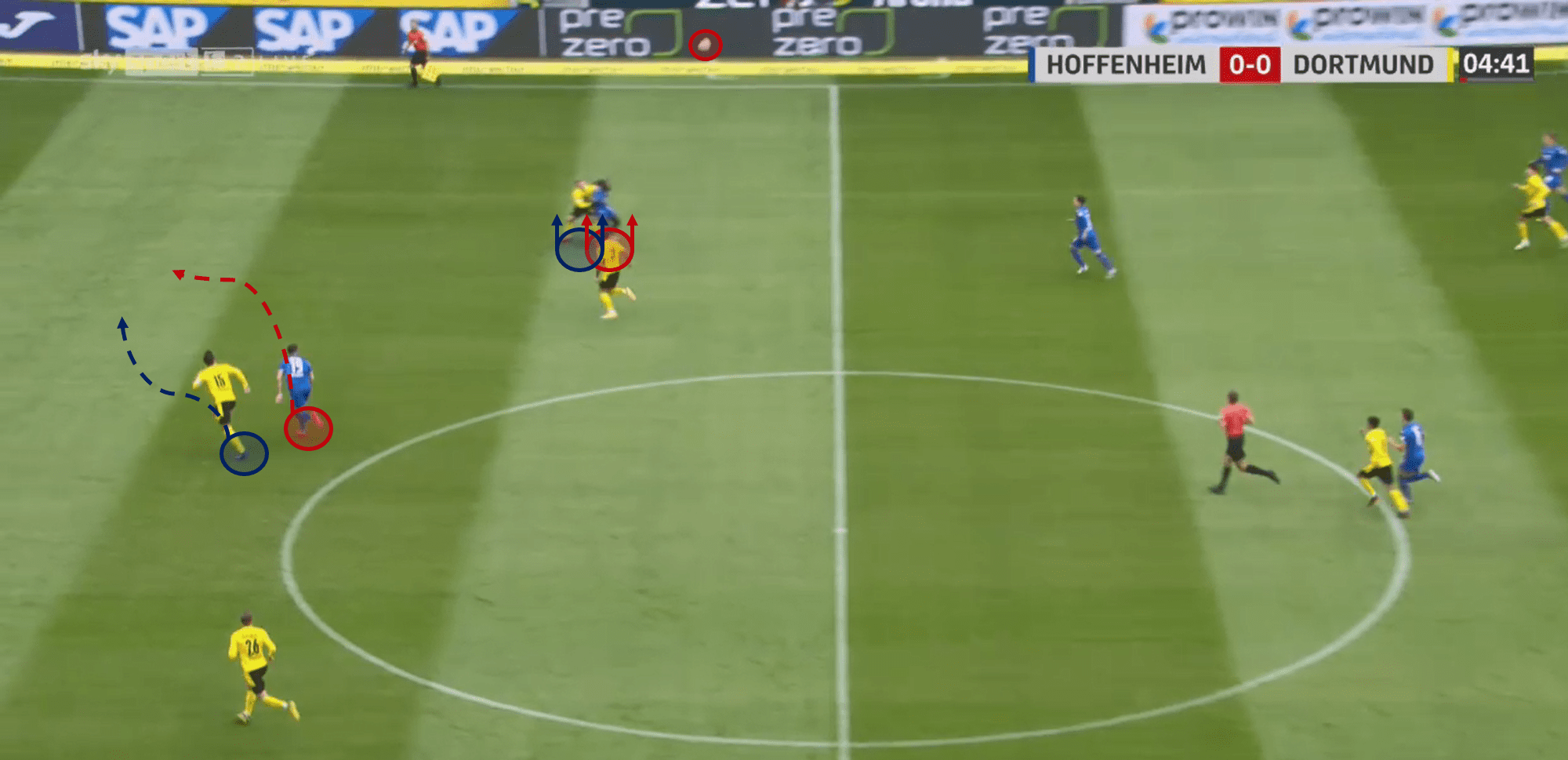
Theoretically, Baumann’s long-range ball would reach Bebou, who would lay off the ball to Belfodil, with only Hummels to deal with down the half-space.
Generally, Hoffenheim like to press high up the pitch, which of course, if not done properly can be exploited quite easily. Especially against Dortmund, who are not against pushing seven or eight men forward in an attacking transition, creating an overload in several zones of play. In this match, as Dortmund grew into the game, Hoffenheim suffered from the space they allowed in behind their defence, with quick attackers such as Sancho and Reyna carrying the ball into very dangerous zones.
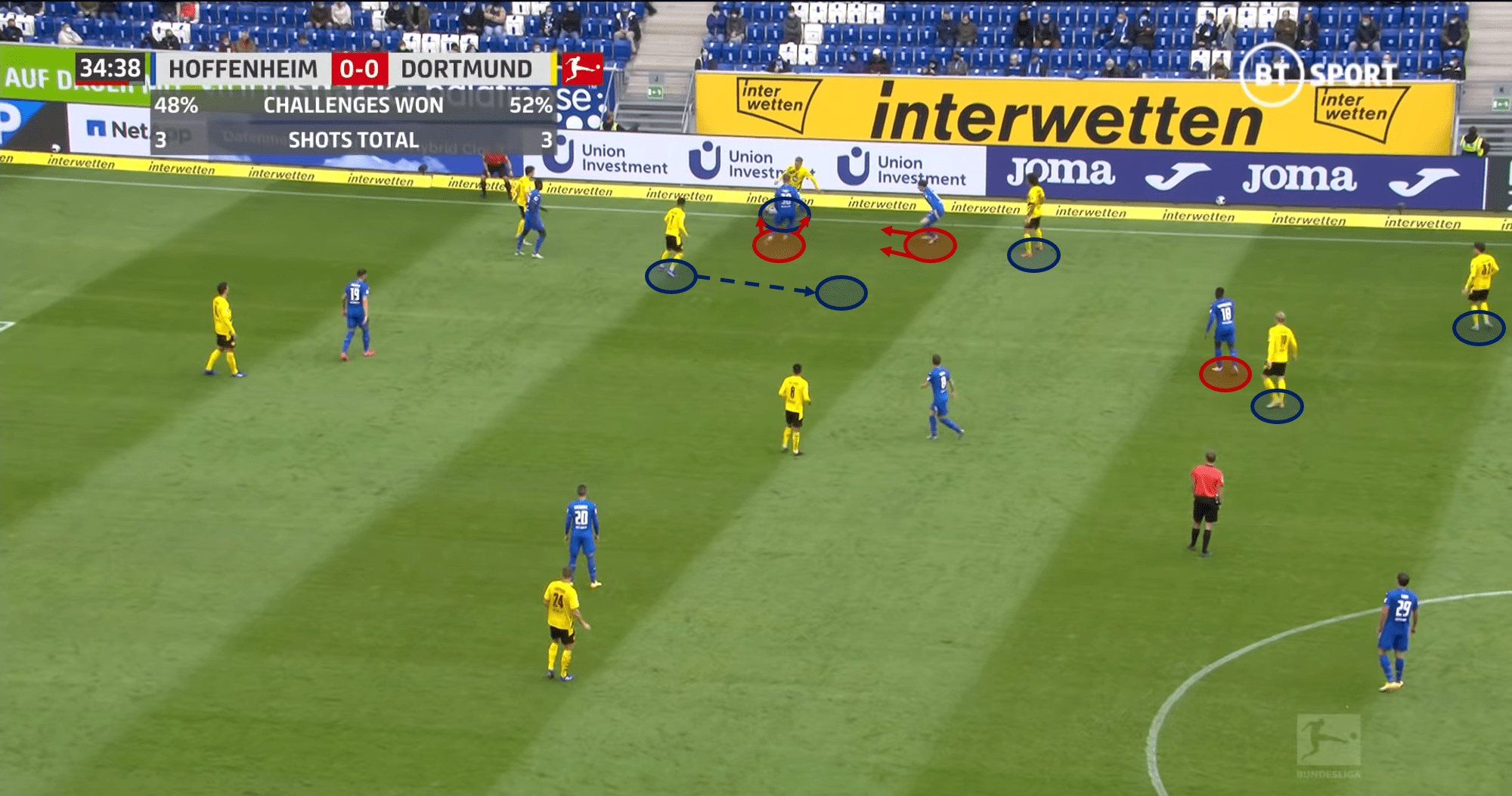
While Hoffenheim would press high to recover the ball, Dortmund’s forward players would sit in positions which would be favourable for a quick counter-attack.
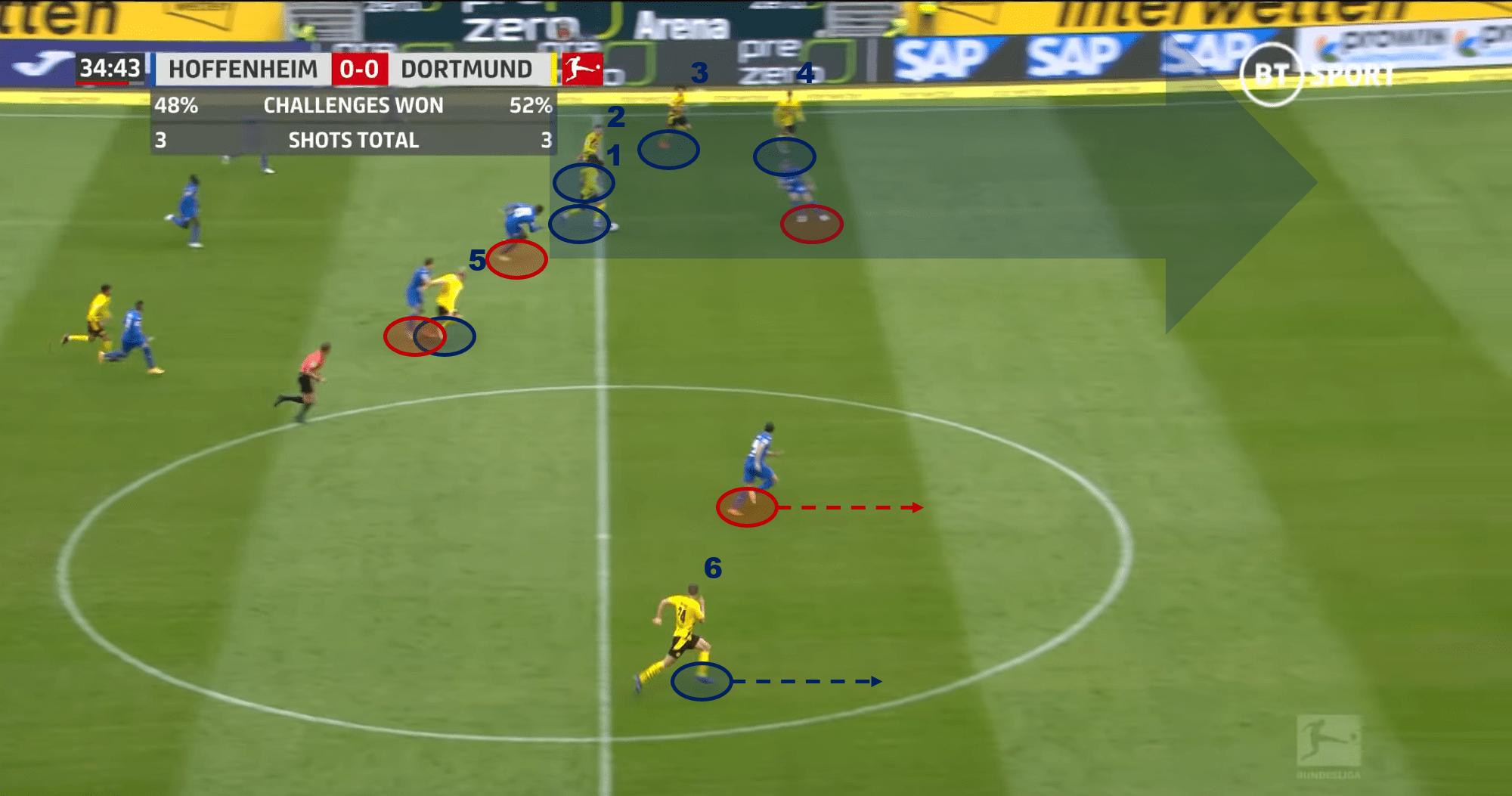
In the above image, we can see how Hoffenheim were undone defensively in this match. They were left unmanned defensively when Dortmund pushed up the field at pace.
Hoffenheim’s (Gaćinović’s) missed chances
Hoffenheim started this match on the strong foot, using their focus down the wide areas to create chances of high quality. The team would start forcing play down one side of the pitch, dragging Dortmund to one flank before quickly distributing it to the other side of the field to the wide man in space. We saw this function of play happen from right to left, with Skov receiving the long ball, before whipping in an early delivery.
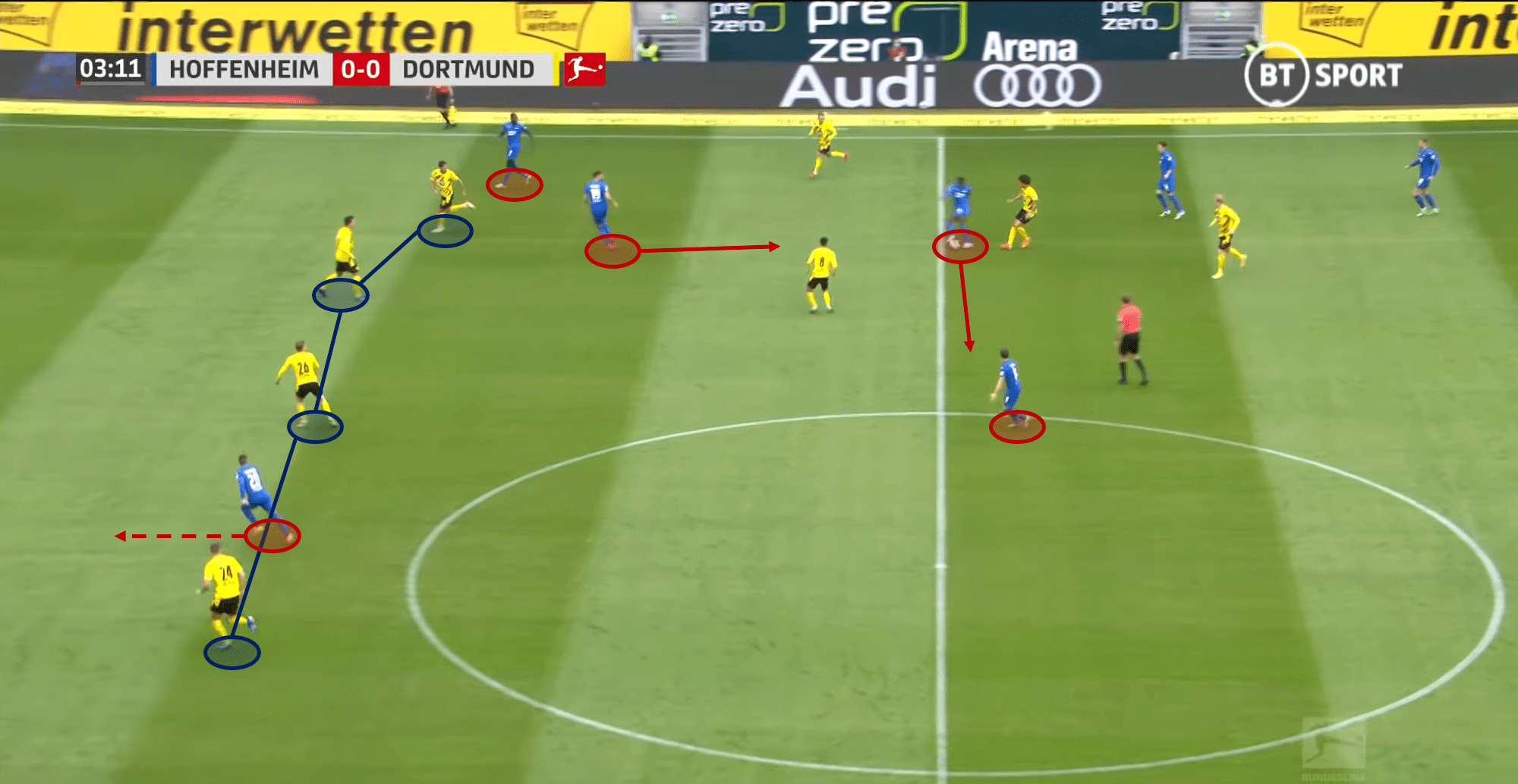
In the above analysis, we see Belfodil play a one-touch pass towards Samassékou, who immediately turns and plays the ball to Geiger. From here, the German lets the ball go through his body and looks towards Skov.
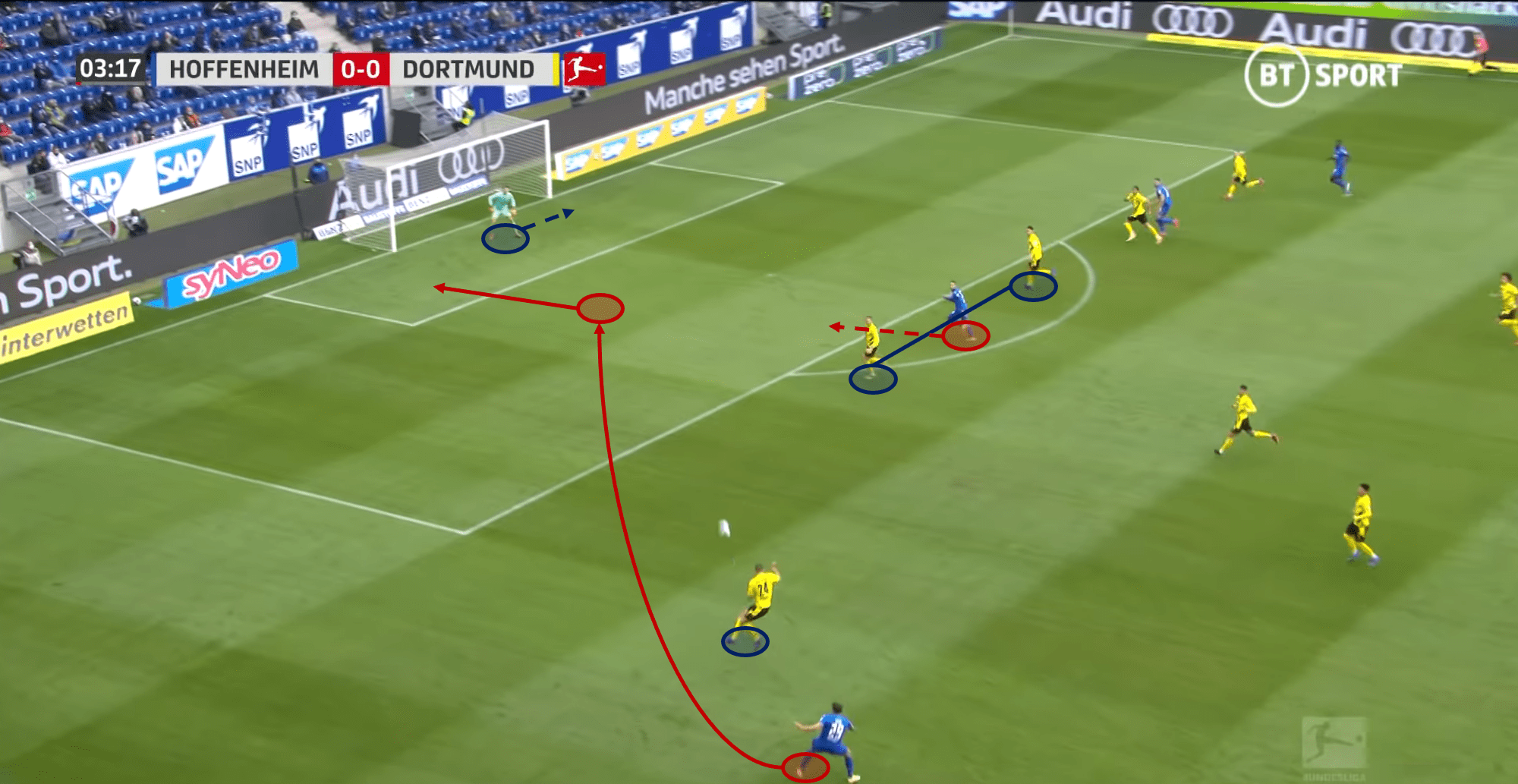
Skov fizzes in a cross towards the six-yard-box for Gaćinović to get on the end of. Hitz moves to his left, allowing the Serbian to place it past his right, but he misses a great opportunity early on.
Due to Skov being better offensively than his wing-back counterpart Rudy in this game, it comes as no surprise that the majority of Hoffenheim’s greatest attacks in this game came through the 24-year-olds side of the pitch. He did well early on in the game, but his threat was nullified as Favre’s men grew into the game.
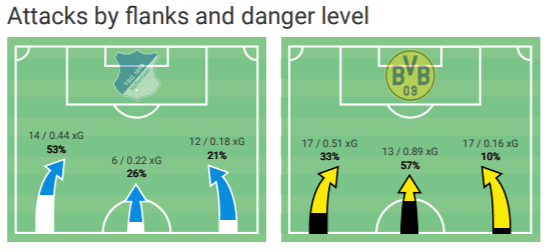
We can see that 0.44 of Hoffenheim’s 0.86 xG came down the left side of the pitch, compared to Dortmund who found the majority of their success down the centre of the field, as we will discuss later on.
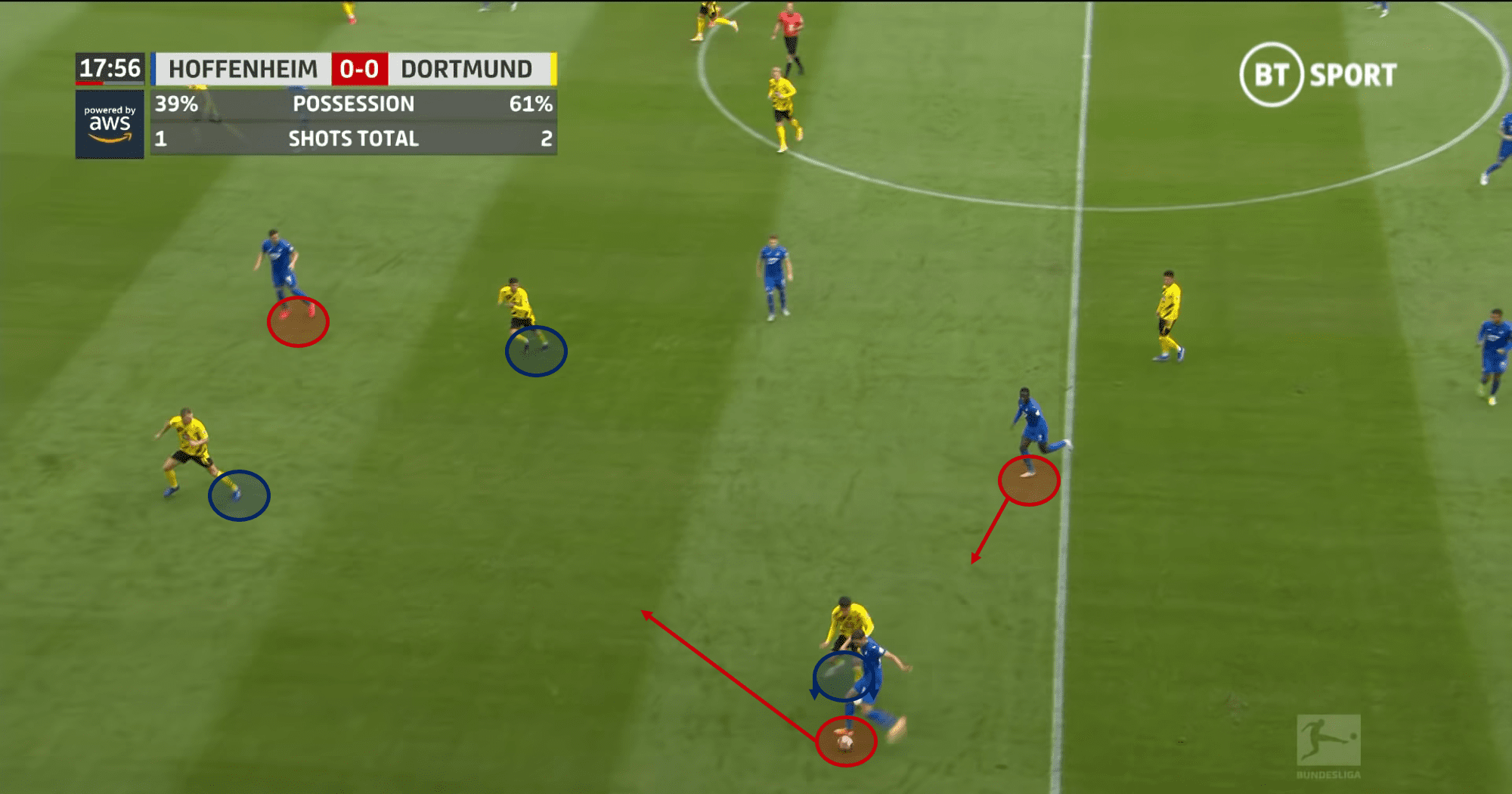
Again, we saw the ball with Skov down the left wide-space, looking to play the ball in-field to Belfodil, who has found himself in a good pocket of space to link up with Gaćinović.
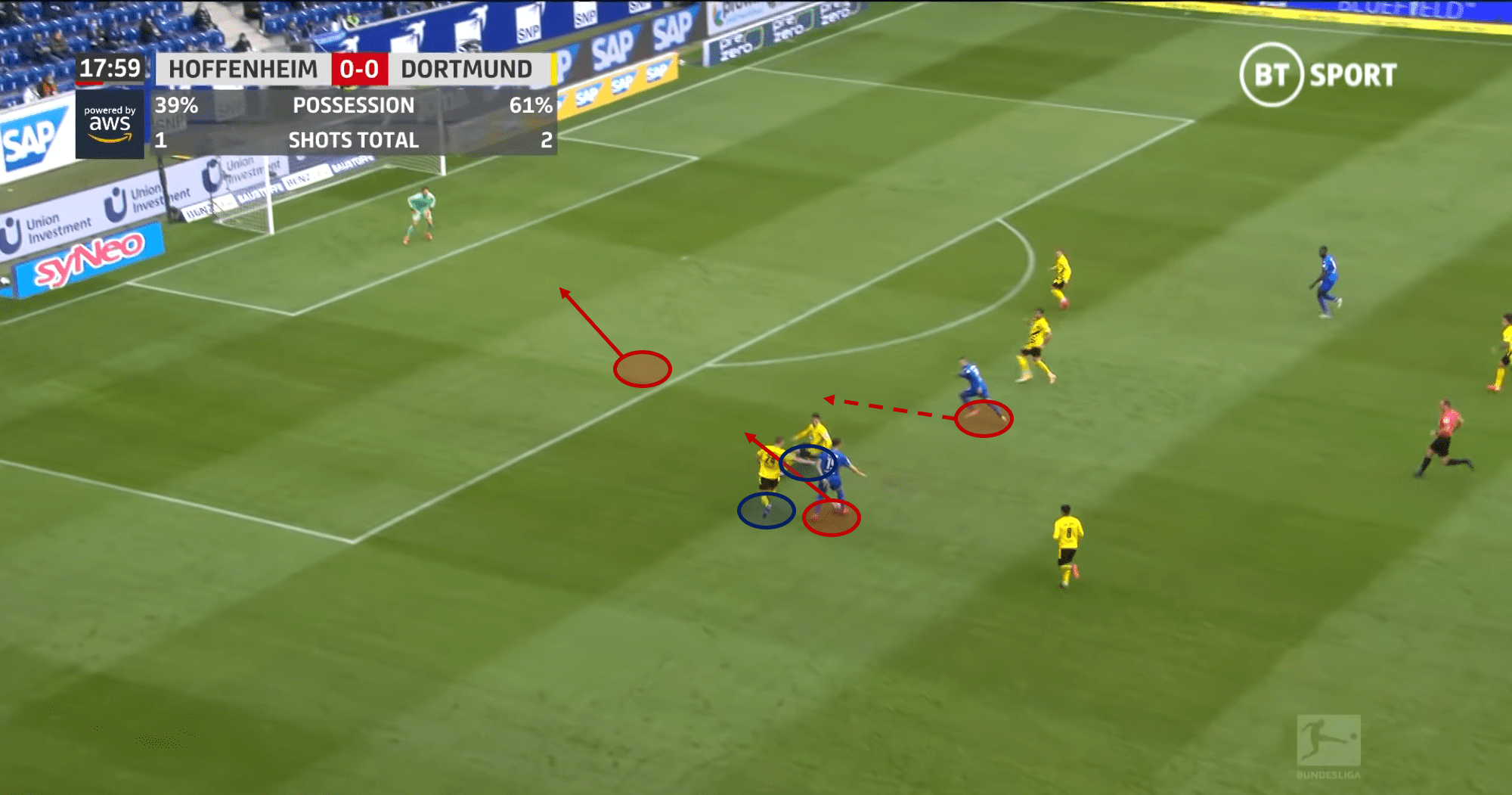
Belfodil plays the disguised pass between the two Dortmund defenders to find Gaćinović’s run, who is now one-on-one with Hitz in goal. Again, he spurns his chance, this time into the arms of the goalkeeper.
Hoffenheim, especially in the second half, really struggled to create chances with regularity. Honess’ men missed the clinical edge of Kramarić, as seven of their nine attempts came from inside the penalty area, but they were unable to convert any at all. They struggled to contend with Dortmund’s physical presence and intense pressing, which saw them give up the ball in the final third on a lot of occasions. In the second-half, where Dortmund has a PPDA value of 7.2, this is where we could see Hoeness’ men particularly struggle to keep possession.
Dortmund counter-attack down the left half-space
Lucien Favre has built a side who understand their roles down to a tee, especially in the build-up phase, displaying a variety of methods to break down an opponent’s press. The wide centre-backs will often pick up the ball and use either the wing-back or the central midfield to fulfil wing rotations to bypass the press. One of the forwards will occupy one of the half-spaces, with the wing-backs providing the overlapping runs which is how they get the ball into the penalty area and create chances.
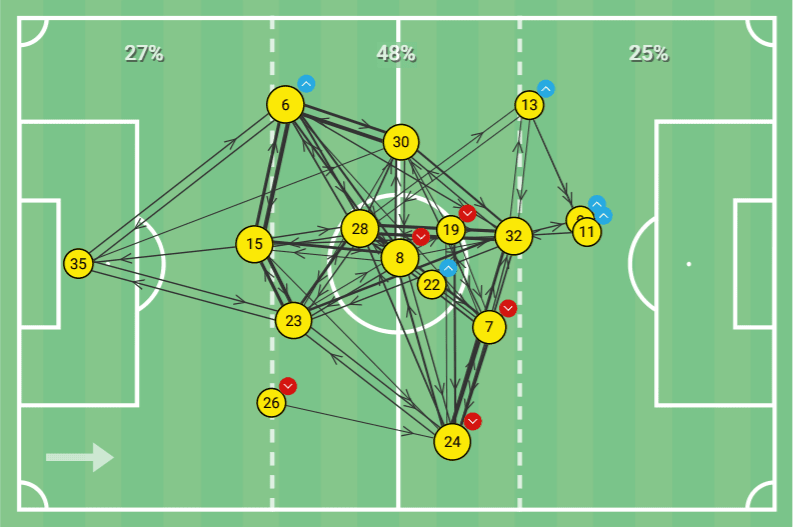
Dortmund’s pass map vs Hoffenheim.
In the build-up phase, while operating within the half-space, Dortmund’s players will often look for the progressive pass, directly into the feet of a forward, who can quickly combine with one of the wing-backs to create a goalscoring opportunity. This is one method of chance creation that Favre’s men have in their toolbelt, and their varied repertoire is what makes them such an effective attacking unit.
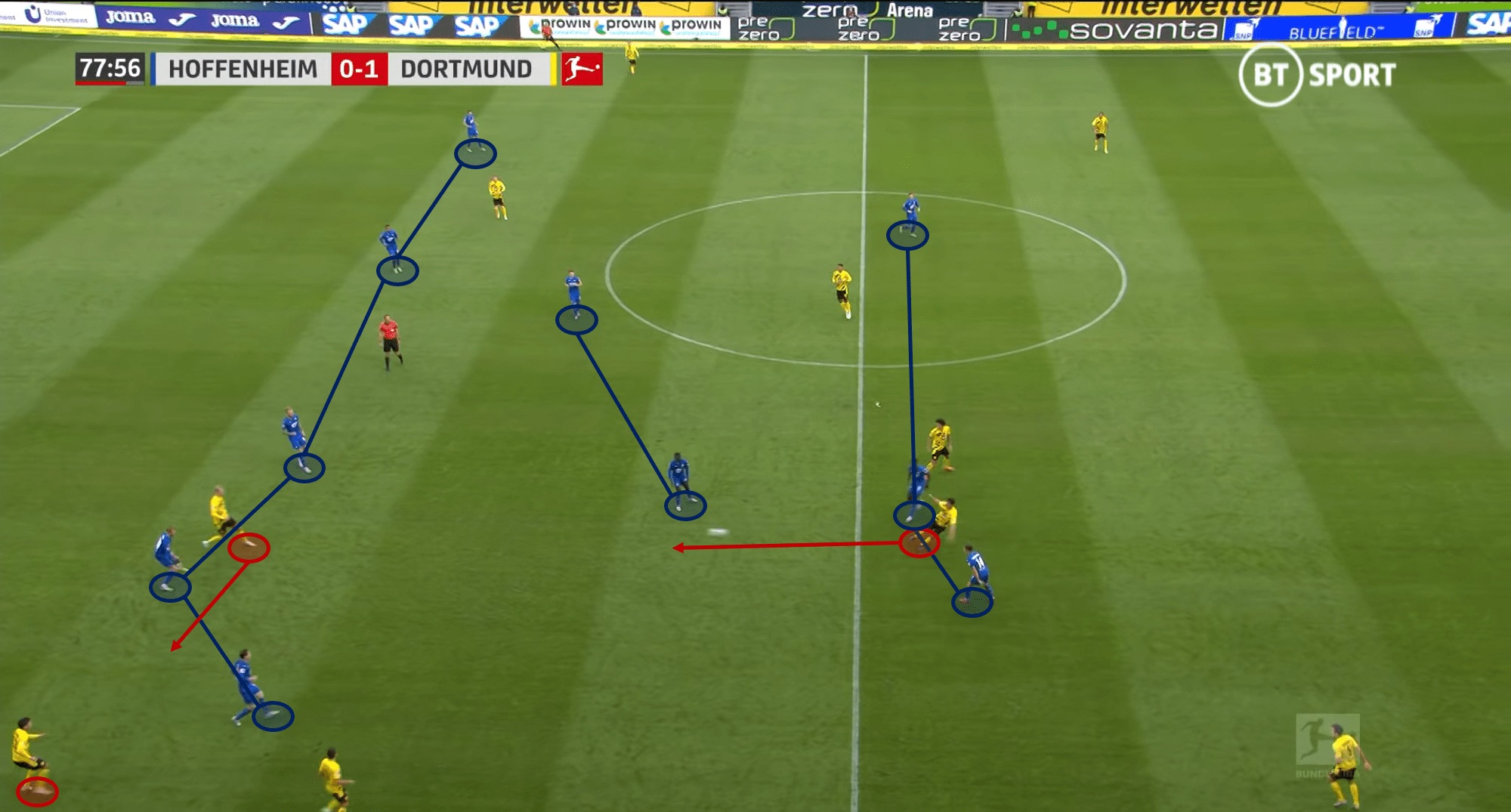
Hummels takes up the ball in a central area and carries into the half-space, before finding Håland with a direct pass, taking out two layers of Hoffenheim press in one pass.
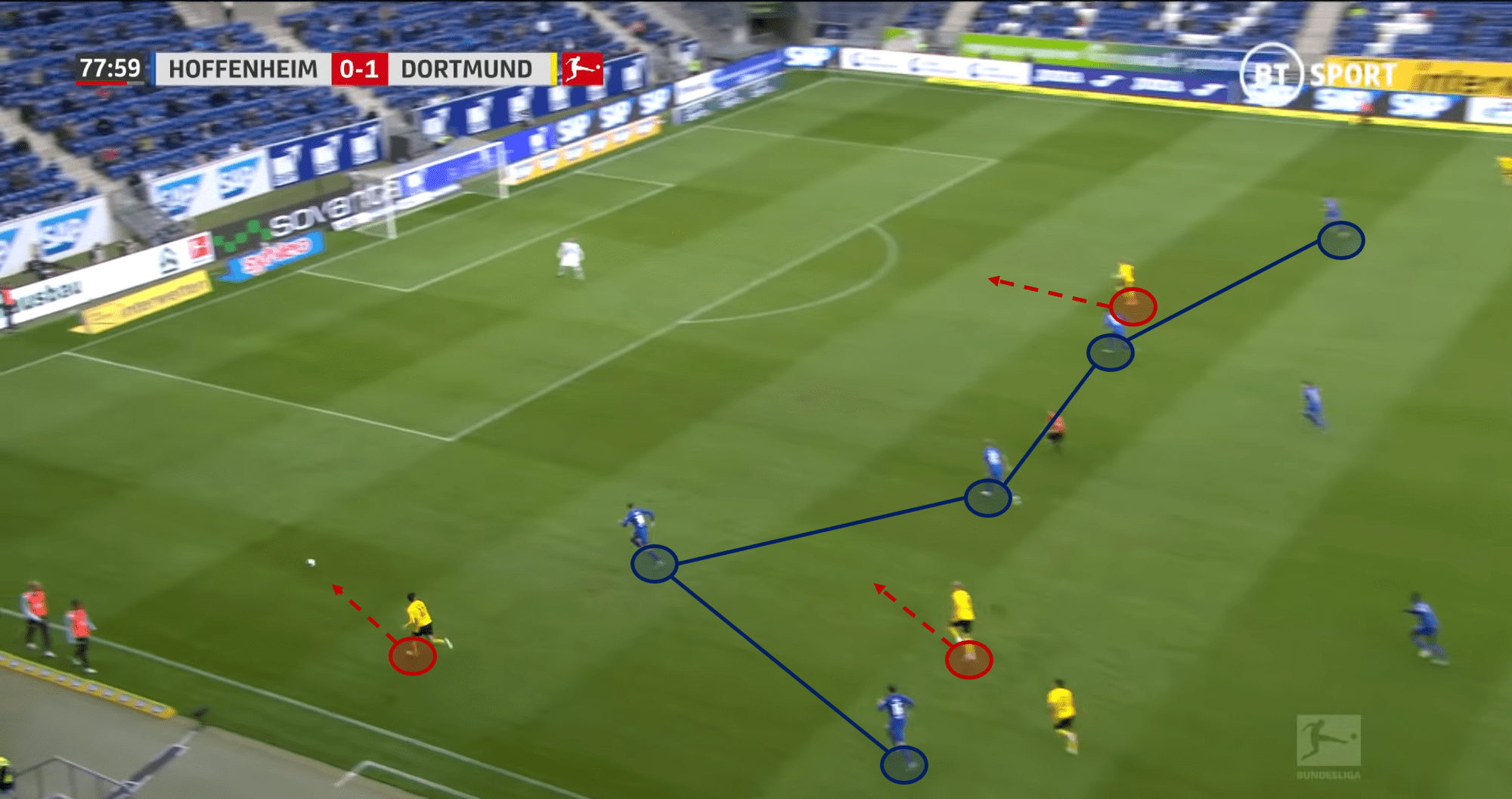
Håland lays off the ball towards Reyna out wide, who has space and time to carry the ball towards the box and find a teammate with a pass. Unfortunately, on this occasion, he travels into a cul-de-sac.
In this match especially, Witsel was an important facilitator in the build-up play within these half-spaces and he linked up well to create passing triangles with his teammates. Dortmund’s constant movement and interchanging of positions meant Hoffenheim would have been exposed in a man-marking system and therefore were forced to sit off from their opposing man to an extent. This saw Dortmund’s attacks per minute rise from 0.36 in the first half to 0.63 in the second half, indicative of their dominance as the game went on.
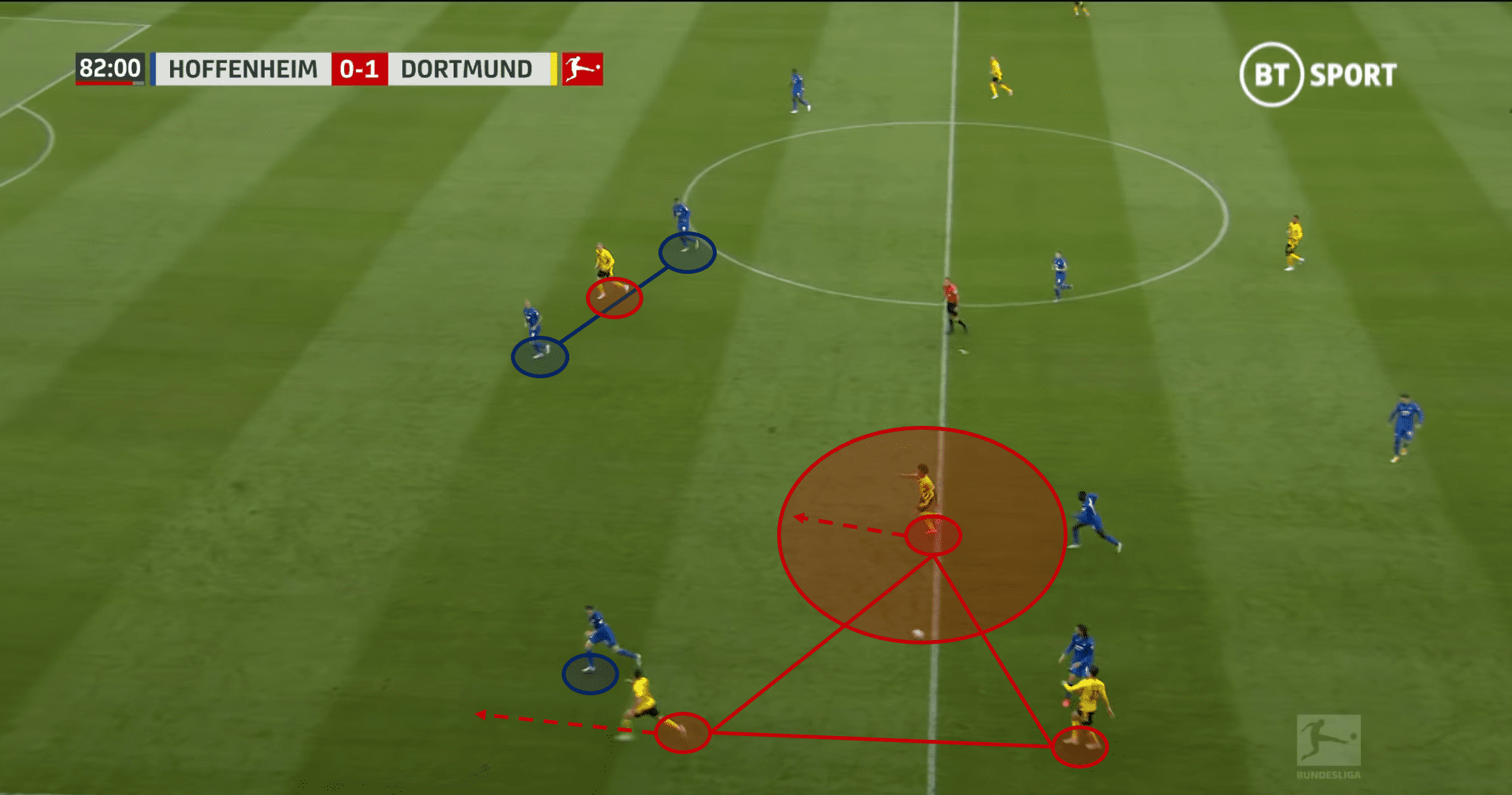
In the above analysis, we can see the passing triangle created by Witsel, Guerreiro, and Reyna. Witsel has time and space to pick out the best passion option either in-field or out wide.
Difference maker Håland
Until the Norwegian powerhouse came onto the pitch, Dortmund were missing a focal point to play off of. A chance occurred early on in the game, where Reyna carried the ball up the pitch into the final third, but when it came to providing the final delivery, the blindsided run usually made by the 20-year-old was not there. Instead, the young American had too many players to choose from and fluffed his lines. Håland came on and brought his intelligent movement with him, and Dortmund created more chances in the process.
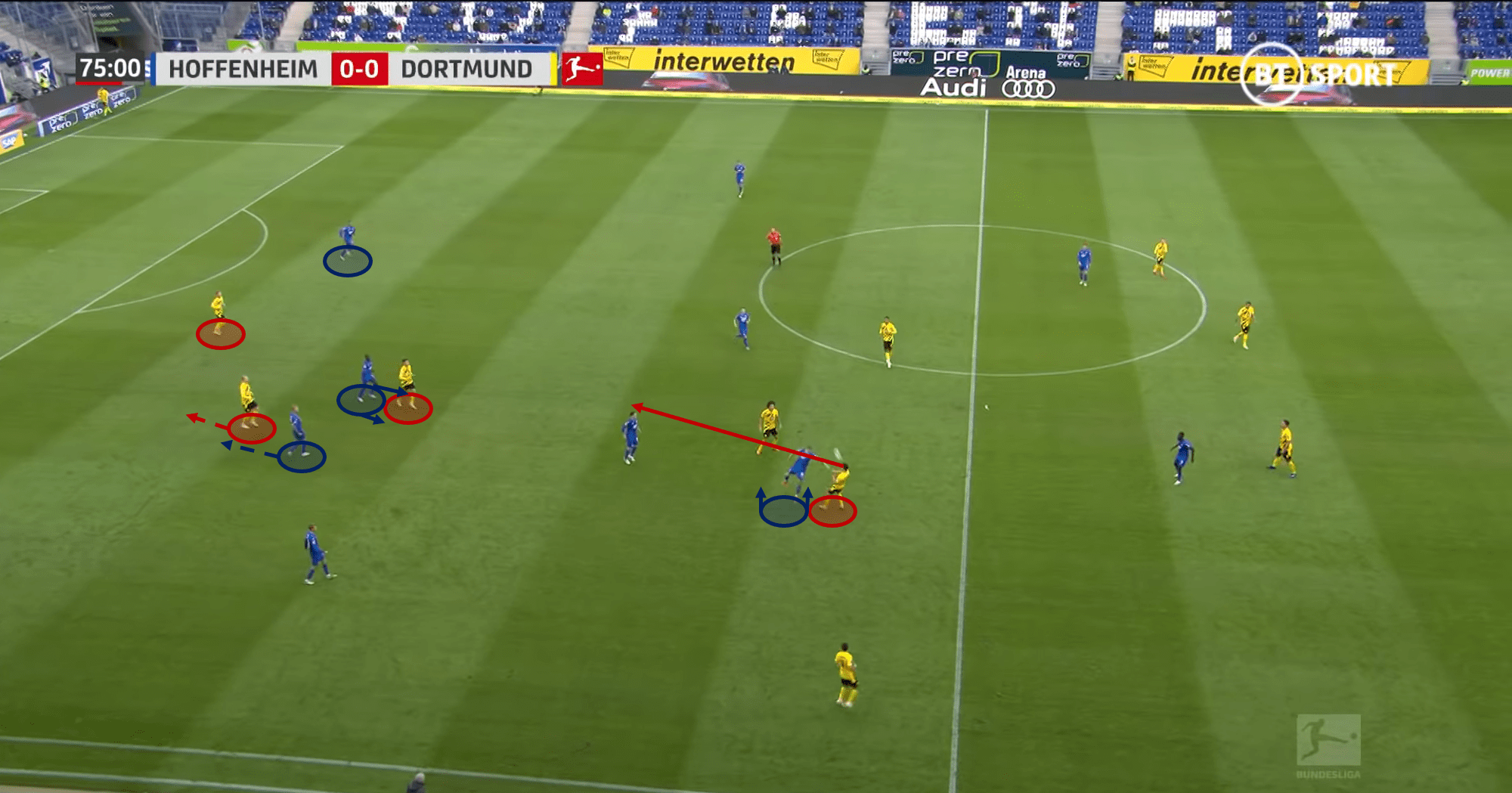
Delaney positions himself well to win the aerial duel and he directs the ball towards an attacking teammate. Håland positions himself so that he is onside and ready to run in behind when necessary.
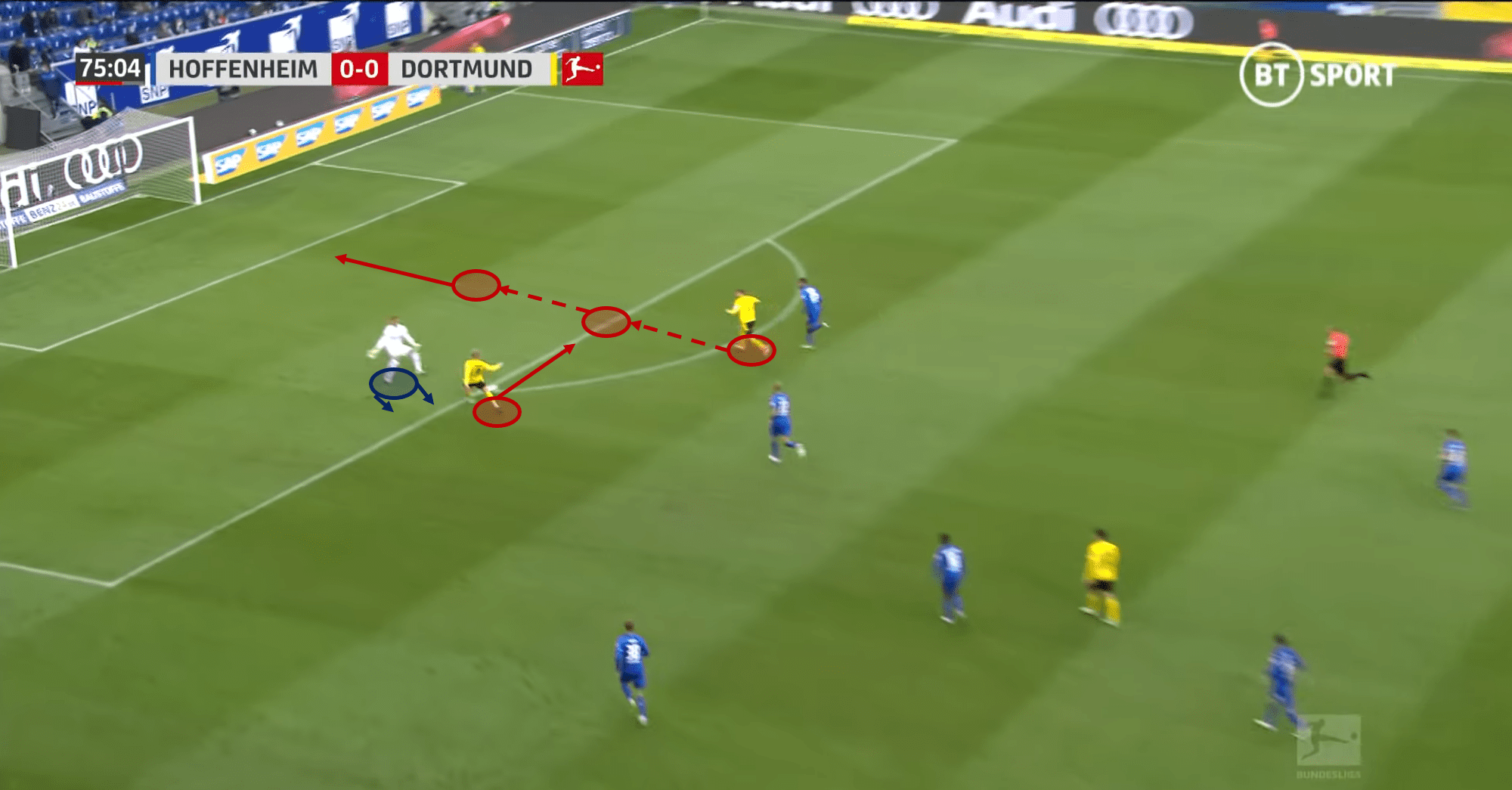
Håland receives the ball and runs towards the penalty area, which invites pressure from Bauman to collect the ball. Håland gets to the edge of the box and cuts back across to Marco Reus, who calmly finishes into an open net.
Håland’s excellent movement in the final-third is seriously impressive, and its importance should not be understated. Players entering the final-third keep a keen eye on his movement because they know an opportunity could arise at any moment. These players will often come from wide areas and into central zones as to create space for the Norwegian to run into.
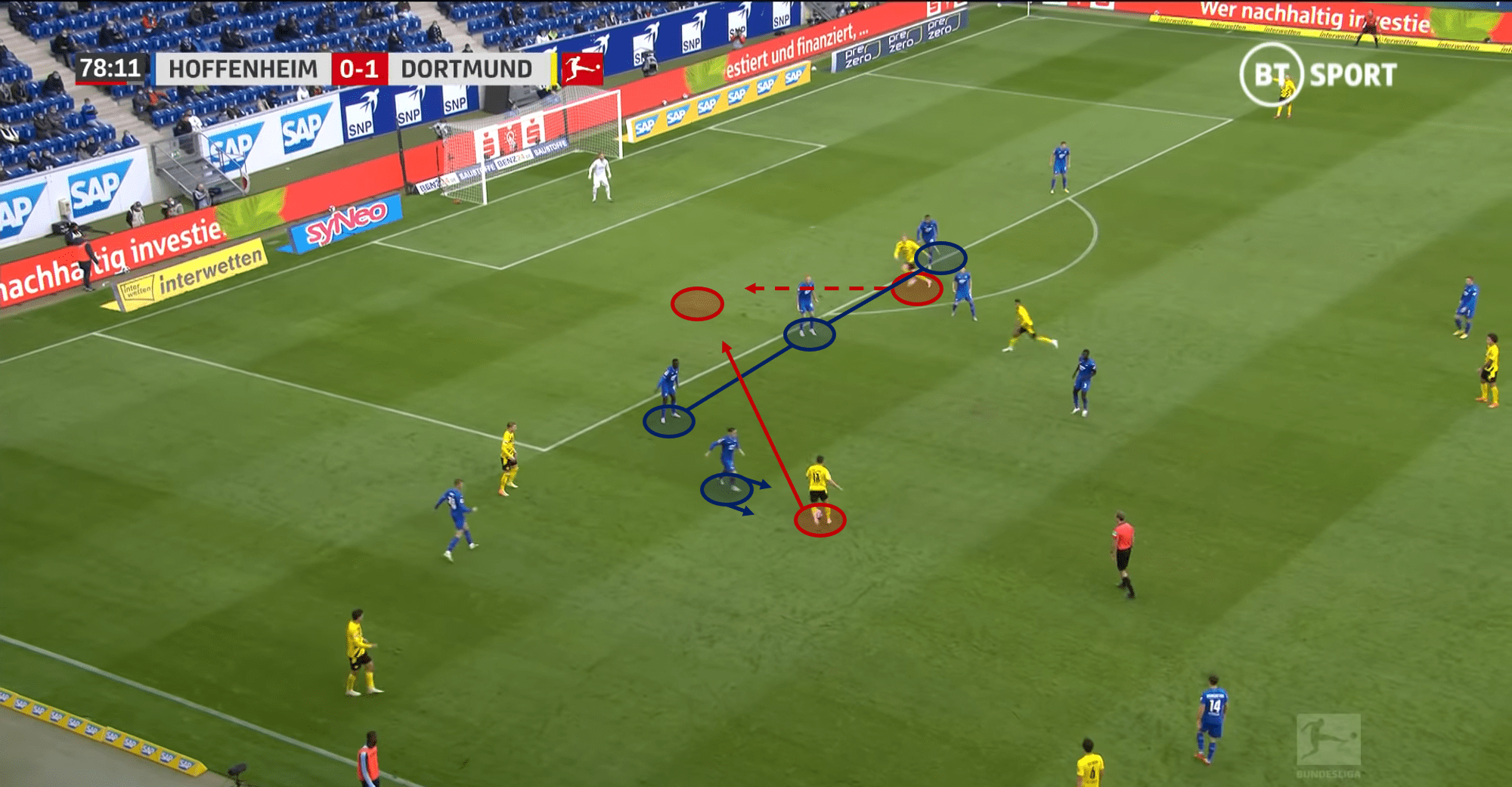
Guerreiro on the ball has come from out wide into a central channel. From here, with pressure on the ball, he can pick out Håland with a simple through ball.
The wonderkid finished the game with two shots, five touches in the penalty area (second-highest in the match), and one key pass to make for an emphatic display. Though, he will be disappointed he did not finish either of the chances he made for himself, as we have seen him score from similar positions in the past. However, if this was an underwhelming performance by his standards then Dortmund have a truly frightening prospect on their hands.
Conclusion
Ultimately, Dortmund put in the better performance in this game, and they can be considered the deserved winners of this tie, with xG backing up this statement by valuing each sides chance 0.86-1.71 respectively.
Favre can come out of this match with mixed emotions. Although his side won, and deservedly so, some of the final-third decision making was questionable before Håland and Reus came onto the field, and Sancho did not look his brightest self in these ninety minutes either. However, his makeshift defence showed a good amount of resilience to make for an impressive display in the defensive phase.
Hoeness will, overall, be disappointed at his side’s display. He will be frustrated that they did not put those early chances away to change the complexion of the game, and he will also be let down by the fact that his team got progressively worse as time went on. Hoeness will want Kramarić to return from his coronavirus bout as soon as possible, as they look a significantly worse attacking unit without the Croatian.





Comments